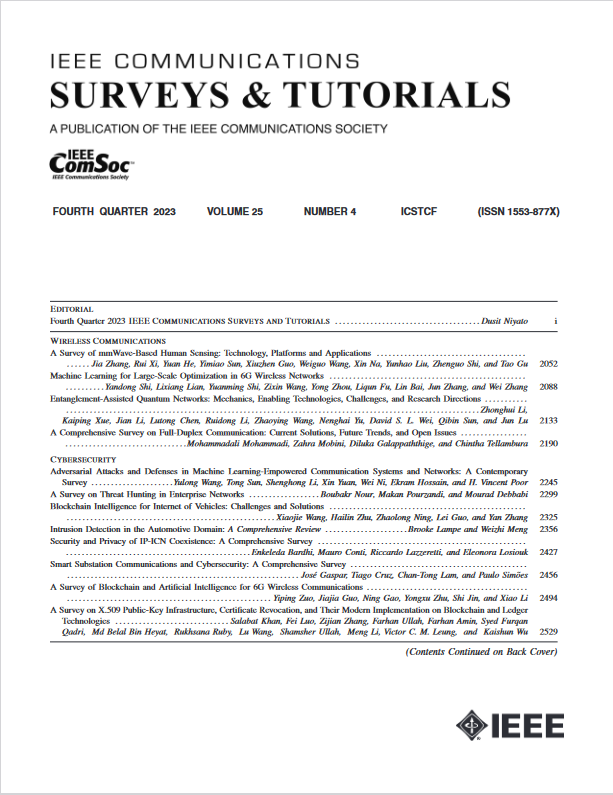多接入边缘计算在视频流中的应用综述:一些研究问题和挑战
IF 34.4
1区 计算机科学
Q1 COMPUTER SCIENCE, INFORMATION SYSTEMS
引用次数: 55
摘要
在智能城市、智能教育、沉浸式服务和联网汽车场景中视频流应用的体验质量(QoE)要求的驱动下,现有网络带来了重大挑战,包括超高带宽、超大存储和超低延迟要求等。多址边缘计算(MEC)是一项潜在技术,其可以为视频流应用提供计算密集型和缓存密集型服务,以满足QoE的要求。因此,以视频流方案为重点,全面总结了将MEC应用于视频流的技术现状。首先,对相关综述和背景知识进行了综述。第二,讨论了资源分配问题。第三,通过考虑缓存、计算和网络,总结了视频流的使能技术。然后,对支持MEC的视频流应用程序进行分类。最后,提出了挑战和未来的研究方向。本文章由计算机程序翻译,如有差异,请以英文原文为准。
A Survey on Multi-Access Edge Computing Applied to Video Streaming: Some Research Issues and Challenges
Driven by the quality of experience (QoE) requirement of video streaming applications in the smart city, smart education, immersive service, and connected vehicle scenarios, the existing network poses significant challenges, including ultra-high bandwidth, ultra-large storage, and ultra-low latency requirements, etc. Multi-access edge computing (MEC) is a potential technology, which can provide computation-intensive and caching-intensive services for video streaming applications to satisfy the requirement of QoE. Thus, focusing on video streaming schemes, a comprehensive summary of the state of the art applying MEC to video streaming is surveyed. Firstly, the related overview and background knowledge are reviewed. Secondly, resource allocation issues have been discussed. Thirdly, the enabling technologies for video streaming are summarized by taking account of caching, computing, and networking. Then, a taxonomy of MEC enabled video streaming applications is classified. Finally, challenges and future research directions are given.
求助全文
通过发布文献求助,成功后即可免费获取论文全文。
去求助
来源期刊

IEEE Communications Surveys and Tutorials
COMPUTER SCIENCE, INFORMATION SYSTEMS-TELECOMMUNICATIONS
CiteScore
80.20
自引率
2.50%
发文量
84
审稿时长
6 months
期刊介绍:
IEEE Communications Surveys & Tutorials is an online journal published by the IEEE Communications Society for tutorials and surveys covering all aspects of the communications field. Telecommunications technology is progressing at a rapid pace, and the IEEE Communications Society is committed to providing researchers and other professionals the information and tools to stay abreast. IEEE Communications Surveys and Tutorials focuses on integrating and adding understanding to the existing literature on communications, putting results in context. Whether searching for in-depth information about a familiar area or an introduction into a new area, IEEE Communications Surveys & Tutorials aims to be the premier source of peer-reviewed, comprehensive tutorials and surveys, and pointers to further sources. IEEE Communications Surveys & Tutorials publishes only articles exclusively written for IEEE Communications Surveys & Tutorials and go through a rigorous review process before their publication in the quarterly issues.
A tutorial article in the IEEE Communications Surveys & Tutorials should be designed to help the reader to become familiar with and learn something specific about a chosen topic. In contrast, the term survey, as applied here, is defined to mean a survey of the literature. A survey article in IEEE Communications Surveys & Tutorials should provide a comprehensive review of developments in a selected area, covering its development from its inception to its current state and beyond, and illustrating its development through liberal citations from the literature. Both tutorials and surveys should be tutorial in nature and should be written in a style comprehensible to readers outside the specialty of the article.
 求助内容:
求助内容: 应助结果提醒方式:
应助结果提醒方式:


